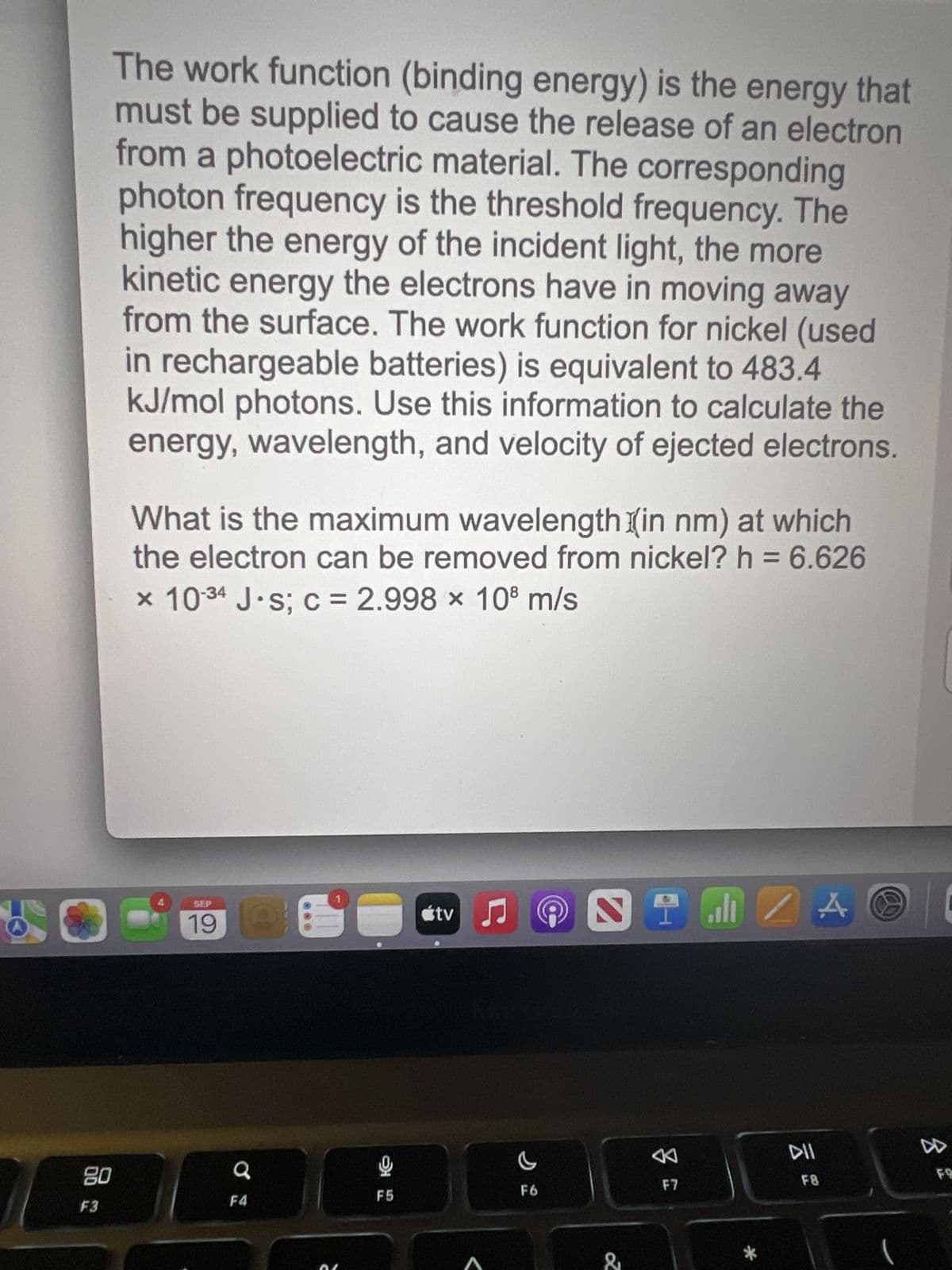The work function (binding energy) is the energy that must be supplied to cause the release of an electron from a photoelectric material. The corresponding photon frequency is the threshold frequency. The higher the energy of the incident light, the more kinetic energy the electrons have in moving away from the surface. The work function for nickel (used in rechargeable batteries) is equivalent to 483.4 kJ/mol photons. Use this information to calculate the energy, wavelength, and velocity of ejected electrons. What is the maximum wavelength (in nm) at which the electron can be removed from nickel? h = 6.626 x 10-34 J·s; C = 2.998 x 108 m/s
The work function (binding energy) is the energy that must be supplied to cause the release of an electron from a photoelectric material. The corresponding photon frequency is the threshold frequency. The higher the energy of the incident light, the more kinetic energy the electrons have in moving away from the surface. The work function for nickel (used in rechargeable batteries) is equivalent to 483.4 kJ/mol photons. Use this information to calculate the energy, wavelength, and velocity of ejected electrons. What is the maximum wavelength (in nm) at which the electron can be removed from nickel? h = 6.626 x 10-34 J·s; C = 2.998 x 108 m/s
Chemistry: The Molecular Science
5th Edition
ISBN:9781285199047
Author:John W. Moore, Conrad L. Stanitski
Publisher:John W. Moore, Conrad L. Stanitski
Chapter5: Electron Configurations And The Periodic Table
Section: Chapter Questions
Problem 114QRT
Related questions
Concept explainers
Atomic Structure
The basic structure of an atom is defined as the component-level of atomic structure of an atom. Precisely speaking an atom consists of three major subatomic particles which are protons, neutrons, and electrons. Many theories have been stated for explaining the structure of an atom.
Shape of the D Orbital
Shapes of orbitals are an approximate representation of boundaries in space for finding electrons occupied in that respective orbital. D orbitals are known to have a clover leaf shape or dumbbell inside where electrons can be found.
Question

Transcribed Image Text:The work function (binding energy) is the energy that
must be supplied to cause the release of an electron
from a photoelectric material. The corresponding
photon frequency is the threshold frequency. The
higher the energy of the incident light, the more
kinetic energy the electrons have in moving away
from the surface. The work function for nickel (used
in rechargeable batteries) is equivalent to 483.4
kJ/mol photons. Use this information to calculate the
energy, wavelength, and velocity of ejected electrons.
80
F3
What is the maximum wavelength (in nm) at which
the electron can be removed from nickel? h = 6.626
x 10-34 J·s; c = 2.998 x 108 m/s
SEP
19
a
F4
F5
tv
♫
c
F6
NIMIZA
&
8
F7
DII
F8
(
|
8
FO
Expert Solution
This question has been solved!
Explore an expertly crafted, step-by-step solution for a thorough understanding of key concepts.
This is a popular solution!
Trending now
This is a popular solution!
Step by step
Solved in 3 steps

Knowledge Booster
Learn more about
Need a deep-dive on the concept behind this application? Look no further. Learn more about this topic, chemistry and related others by exploring similar questions and additional content below.Recommended textbooks for you

Chemistry: The Molecular Science
Chemistry
ISBN:
9781285199047
Author:
John W. Moore, Conrad L. Stanitski
Publisher:
Cengage Learning

Chemistry: Principles and Reactions
Chemistry
ISBN:
9781305079373
Author:
William L. Masterton, Cecile N. Hurley
Publisher:
Cengage Learning

Principles of Modern Chemistry
Chemistry
ISBN:
9781305079113
Author:
David W. Oxtoby, H. Pat Gillis, Laurie J. Butler
Publisher:
Cengage Learning

Chemistry: The Molecular Science
Chemistry
ISBN:
9781285199047
Author:
John W. Moore, Conrad L. Stanitski
Publisher:
Cengage Learning

Chemistry: Principles and Reactions
Chemistry
ISBN:
9781305079373
Author:
William L. Masterton, Cecile N. Hurley
Publisher:
Cengage Learning

Principles of Modern Chemistry
Chemistry
ISBN:
9781305079113
Author:
David W. Oxtoby, H. Pat Gillis, Laurie J. Butler
Publisher:
Cengage Learning

Chemistry
Chemistry
ISBN:
9781305957404
Author:
Steven S. Zumdahl, Susan A. Zumdahl, Donald J. DeCoste
Publisher:
Cengage Learning

Introductory Chemistry: A Foundation
Chemistry
ISBN:
9781337399425
Author:
Steven S. Zumdahl, Donald J. DeCoste
Publisher:
Cengage Learning

Chemistry: An Atoms First Approach
Chemistry
ISBN:
9781305079243
Author:
Steven S. Zumdahl, Susan A. Zumdahl
Publisher:
Cengage Learning